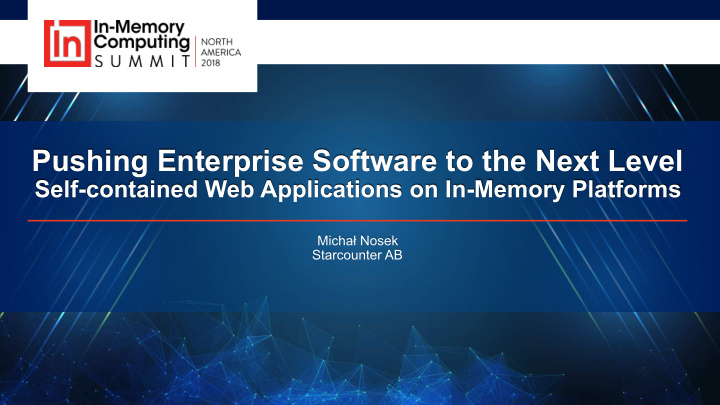



Pushing Enterprise Software to the Next Level Self-contained Web Applications on In-Memory Platforms Micha ł Nosek Starcounter AB
Who am I? ▪ Micha ł Nosek Software Engineer, Technical Sales Engineer – Starcounter http://starcounter.com ▪ Github: mmnosek LinkedIn: https://www.linkedin.com/in/mmnosek E-mail: michal@starcounter.com Twitter: @mmnosek
On Today’s Agenda 01 Setting the Stage RAM Memory Modern WEB SCS Architecture 02 In-Memory Application Platform Architecture Single App Integration Demo Future
Enterprise Software of Today Micro-Services Monolith ▪ Orchestration ▪ Bad maintainability ▪ Eventual consistency ▪ Long builds ▪ Communication problems ▪ Technology lock-in ▪ Complexity ▪ Long TTM ▪ Poor scalability
Wirth’s law “What Intel giveth, Microsoft taketh away.” “What Andy giveth, Bill taketh away”
On Today’s Agenda 01 Setting the Stage RAM Memory Modern WEB SCS Architecture 02 In-Memory Application Platform Architecture Single App Integration Demo Future
RAM Prices Price of 1MB in USD over time 1000,00000 100,00000 10,00000 1,00000 USD 0,10000 0,01000 0,00100 0,00010 0,00001 1980 1990 2000 2010 2020 Year https://jcmit.net/memoryprice.htm
Conventional In-Memory
Conventional In-Memory
Pros and Cons Cons Pros ▪ Communication isn’t faster ▪ Getting faster ▪ It’s not durable ▪ Better utilised by modern CPUs ▪ Not getting cheaper anymore?
On Today’s Agenda 01 Setting the Stage RAM Memory Modern WEB SCS Architecture 02 In-Memory Application Platform Architecture Single App Integration Demo Future
Pros and Cons Cons Pros ▪ Still not implemented everywhere ▪ Ubiquitous (no native, separate process) ▪ Global scope (one app can break ▪ Semantics (content) vs Presentation something in another) ▪ Modularity as priority (reusability) ▪ Online requirement
On Today’s Agenda 01 Setting the Stage RAM Memory Modern WEB source: SCS Architecture scs-architecture.org 02 In-Memory Application Platform Architecture Single App Integration Demo Future
SCS Architecture
SCS Architecture
SCS Architecture
SCS Architecture System 1 System 2
Pros and Cons Cons Pros ▪ Integration ▪ Modularisation ▪ Common look and feel ▪ Maintainability ▪ Inconsistency ▪ Loose coupling
On Today’s Agenda 01 Setting the Stage RAM Memory Modern WEB SCS Architecture 02 In-Memory Application Platform Architecture Single App Integration Demo Future
In-Memory Application Platform For Building Self-Contained Systems
General Platform Architecture Front-end Framework React, Polymer Communication Palindrom - REST, Web Sockets Application View Models, Entities, App Logic In Memory App Platform Mapping, Persistence, Queries Starcounter
Traditional Stack vs Starcounter Stack
Data Storage • In-Memory database • ACID compliant • Snapshot isolation • Flexible
VMDBMS U.S. Patent No. 8,266,125
Business Logic • Polyglot • Simplified • Platform-agnostic • Real-time
User Interface • Web native • Web socket communication • Design agnostic • Thin
Demo: Simple SCS app
Integration: Data Level
UI A UI B UI C App A App B App C Model A Model B Model C Mapper Starcounter
Integration: UI Level
UI B UI A UI C UI A UI B UI C App A App B App C Model A Model B Model C Starcounter
Outcomes Cons Pros ▪ Integration ▪ Modularisation ▪ Different look and feel ▪ Maintainability ▪ Inconsistency ▪ Loose coupling ▪ Platform lock-in? ▪ Full and easy integration ▪ Common look and feel ▪ Consistency
Storage Engine Benchmark Full-Stack Benchmark ▪ 1.5 mln. accounts, 500 K remote clients transfer. ▪ YCSB load 5% writes, 95% reads. ▪ Money between accounts (5%) and read totals ▪ 1 x E5-2680v2, 1 machine (10/20 cores/ (95%). threads). ▪ Transfer and read operations are mixed randomly. ▪ 8 threads: 3.5 mln. Ops/sec. ▪ Starcounter on .NET (1 x EC2 c3.8xlarge): 1 M ▪ 16 threads: 5.4 mln. Ops/sec. OPS. ▪ MariaDB Galera Cluster 5 nodes with Node.js app ▪ c3.8xlarge – 60 GiB RAM, 32 vCPUs server (5 x EC2 c3.2xlarge, EBS root volume and ▪ c3.2xlarge – 15 GiB RAM, 8 vCPUs high network throughput, stored procedures): 55 K OPS. ▪ https://www.ec2instances.info/ ▪ Ratio suffers for MariaDB doing more writes.
On Today’s Agenda 01 Setting the Stage RAM Memory Modern WEB SCS Architecture 02 In-Memory Application Platform Architecture Single App Integration Demo Future
Currently vs Future Registers Registers Cache Cache Main Memory Main Memory Solid State Disk Non Volatile Memory Solid State Disk Magnetic Disk Magnetic Disk Current Future
Starcounter in the Future
Enterprise ▪ Simplified Software of ▪ Near real-time Tomorrow ▪ Easy to maintain ▪ Reusable/modularised ▪ Fully web-based ▪ Fast data ▪ HTAP or HOAP
THANK YOU! Questions?
Recommend
More recommend